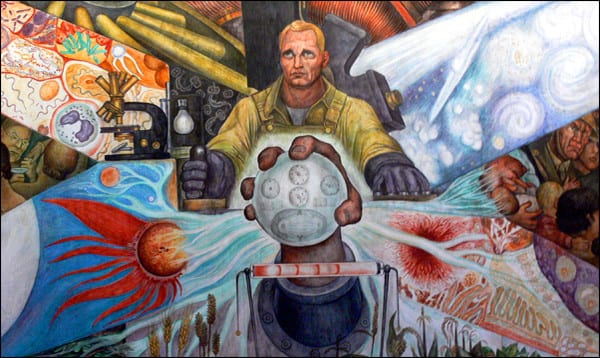
The main figure in the famous painting 'Man at the Crossroads’ by Diego Rivera, is described as being “at a crossroads, looking with hope and high vision, to the choosing of a new and better future.” An apt description for many performing arts theaters across the country. This post looks at the hopes and high visions theaters have for funding goals, talent management, and the theatre ticketing systems in use. The trials & tribulations can serve as a barometer for the performing arts industry as well as a "dreamboard" for theater owners.
If You Build It, They Will... Pay?
One example of “hope and high vision” can be found in Federal Way, Washington, just south of Seattle. The Federal Way city council recently held a special meeting to discuss their vision of a new cultural center as part of a larger downtown revitalization project. The meeting was open to the public and to the press, including columnist Matthew Jarvis. One of the venues cited as inspiration, Jarvis notes, was the McIntyre Hall Performing Arts Center (video above) which is also located in Washington state.
Jarvis’ pragmatic account of the meeting, titled If we build an arts center, who will pay?, stops just short of criticizing the council’s “hope and high vision” outright:
As I watched slides with beautiful renditions of possible designs, I found myself thinking that maybe, just maybe, a [cultural center] might be the very thing that could revitalize Federal Way’s downtown. I was pleasantly surprised to see the exceptional team of designers, architects and builders the city assembled - a team who is willing to personally guarantee against cost overruns.
My excitement faded, however, when I saw that the city has not yet figured out how to pay for construction, nor is there a viable operating plan.
In his assessment of what it would take for the city to build a new cultural center, Jarvis includes city bonds, tax hikes, deferred billing by contractors, and charity donations as possible solutions. Surprisingly, Jarvis does not mention ticket sales, via modern theatre ticketing systems, as a source of (future) revenue.
A skeptical eye on the city’s estimates is cast by Jarvis, stating projections do not reflect the true costs of the a project - “I did my own analysis of the numbers. In my professional opinion, the losses/taxpayer subsidy in the first five years will be at least double what the city has projected.”
Any theater owner knows theatre ticketing systems are important. Additionally, any owner who has been part of new construction may recognize Jarvis’ dissenting opinion. Expanding or building a new theater is often more than simply raw numbers, it is a campaign to build public confidence. The public may balk at the initial costs of a cultural center and not immediately recognize its long term benefits. Cultural enrichment has proven time and again to improve quality of life, raise property values, and make a city a better place to live - once the initial costs have been amortized over decades.
Jarvis concludes his written opinion on a relatively positive note:
If you ignore the funding issues, and the lost tax revenues, and the lack of a comprehensive plan, building [may] be one of the best things to happen to Federal Way. As such, I thank supporters for their diligent efforts to make Federal Way a better place.
South Seattle is not the only place where the performing arts are at a crossroads...
The Dream Board
Citizens in the Canadian city of Kamloops, British Columbia are all abuzz with what they want in a new performing arts center. The public’s interest peaked earlier this week during a “public input session” conducted by the city.
Construction of a new cultural center is at the crossroads of wishful thinking and harsh fiscal realities, says Andrea Klassen.
A new museum, access to shopping, an auditorium with decent acoustics, a good bar. These are a few of the features Kamloopsians want to see in a new performing-arts center according to the approximately 200 participants who turned out.
Jessie Paynter, an assistant technical director for Western Canada Theatre, said Sagebrush Theater, where she works, doesn't work well for choral groups or all kinds of productions. “It’s a great space,” Paynter said of Sagebrush. “I love that space, but there’s a lot of problems with it.” She wants to see a larger theater that can accommodate more types of acts. A few attendees, however, were there to raise concerns about what they see as a costly project that will only benefit a niche group.
In a rather unconventional move, the meeting made use of a so-called dreamboard. A dreamboard, popularized by TV personality Oprah Winfrey, is a presentation device (such as a cork-board or pin-up board) where ideas and suggestions are placed. The dreamboard serves as a visual focal point for all involved in a project. Klassen published the dreamboard suggestions made in pursuit of a new performing arts center, including:
- Lobby with view, bar and space for pre-program presentations
- The new building could also house the Big Little Science Centre.
- “We need a new museum!”
- Place to hang artwork and a nice place to eat
- “It’s got to be better than what Kelowna has
Use of a dreamboard may be of interest to theater owners as it is a great way for new ideas and suggestions from staff to gain momentum. Dreamboards may be physical objects or a virtual ones with ideas compiled via the internet using Google Docs.
However, all the dream boards in the world, filled with boundless hope and high vision, will never be a substitute for ticket revenue. In fact, ticket revenue was the topic of discussion at another theater...
At La Crosse Roads
A cooperative effort between a community theater company and Viterbo University in La Crosse Wisconsin, has resulted in a new venue called the Weber Center for the Performing Arts. Although the Weber Center is yet to officially open its doors to the public, the spectre of higher ticket prices is already materializing.
Geri Parlin writes that during a recent theater company meeting, a plea to keep the ticket prices as low as possible (“Please consider those who want to come to the theater. It needs to be a price range they can afford!”) was made. Parlin’s article contains some very salient points for theater owners:
Executive Director David Kilpatrick said that will be discussed and a pricing schedule will likely be announced when they announce next year’s season on April 6. That could mean charging more on popular nights such as Friday and Saturday and less on Thursdays and Sundays. Or charging more for some seats than others. [In order] to let volunteers, season ticket holders and everyone else weigh in on the topic, a survey will be set up on the theater website.
The fact that the theater has nearly sold out all of its performances for the season, yet needs to raise ticket prices to cover operating costs, may be symptomatic of a shortcoming in the ticketing software being used.
Theatre Ticketing Systems For Whatever Road You Choose
 Demand pricing, charging more for certain sections of seats, and making use of surveys during the ticket purchase process, are advanced features of some, but not all, theatre ticketing systems.
Demand pricing, charging more for certain sections of seats, and making use of surveys during the ticket purchase process, are advanced features of some, but not all, theatre ticketing systems.
The ThunderTix plan for performing arts theaters can include interactive seating charts for tiered or on-demand pricing by section. We also offer you the tools to create custom surveys and prompt for donations, both presented during the purchase process. ThunderTix as a performing arts ticket software makes managing your theater's events easy. ThunderTix allows you to sell tickets online with no fees.
If you want to sell tickets online, be sure to take a look at all the features we have to offer and sign up for a free trial today!